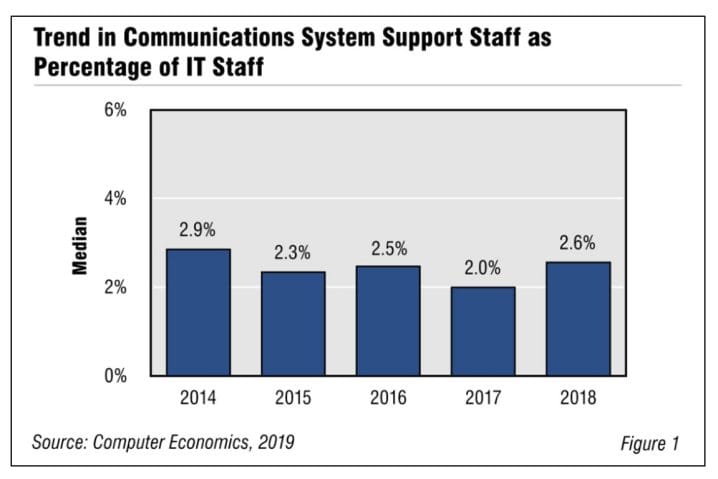Corporate communications systems have become more sophisticated in recent years. As a result, it is becoming more difficult to determine how to staff the role of supporting them. Consumerization, driven by apps on mobile devices, has created a wider array of communications options for users, and they are demanding this choice within the workplace as well. Because of the changing preferences and variety of communication technologies, the size of the communications system support staff as a percentage of the IT staff has been prone to large fluctuations in recent years.
As shown in Figure 1 from our full report, Communications Support Staffing Ratios, the ratio jumped in 2018 to 2.6% from 2.0% in 2017.

Part of the reason for this volatility is because communications personnel make up such a small portion of the total IT staff. As a result, small changes make for big changes to the percentage. But the volatility is also because consumer devices are driving new demands for communications in the enterprise.
“We all use smartphones for email, texts, instant message, social media, and face-to-face video communications,” said Tom Dunlap, director of research of Computer Economics, a research firm in Irvine, Calif. “We expect the same level of service at work. When that doesn’t happen, we’re likely to turn to our own solutions, which puts the company’s data in a vulnerable position.”
And it is not just end users demanding these changes. Customers are increasingly demanding to be contacted through a broader range of methods. The days where a salesperson relied on cold calling or handing out business cards are long gone. Even in a B2B setting, customers expect to be able to interact with potential partners via multiple channels including video conference, social media, email, and text.
Another complicating factor in communications systems is the rise of telecommuting. The percentage of employees working from home has exploded in the past decade, and as more workers are logging in from home, traditional office communication applications are not up to the task. If companies are going to allow their employees to work from home, it becomes important that they implement tools to allow their employees to stay connected.
The personnel who comprise the communications system support staff include engineers, analysts, specialists, and administrators, who manage email, messaging, telephony, videoconferencing, unified communications, and other communications systems. We place this support staff within a broader classification of the Network and Communications Group.
The full report will help IT managers determine whether their organization is keeping pace with changes in communications systems by comparing their support staff against industry benchmarks. The study uses three metrics to make that assessment: communications system support staff as a percentage of the IT staff, percentage of support staff in relation to organization size, and communications support staff spending per user. We provide benchmarks for the composite sample, by organization size and sector. We also provide a benchmark for the larger Network and Communications Group. We conclude with recommendations for optimizing the productivity of communications system support personnel.
This Research Byte is a brief overview of our management advisory on this subject, Communications Support Staffing Ratios. The full report is available at no charge for Avasant Research subscribers, or it may be purchased by non-subscribers directly from our website (click for pricing).

